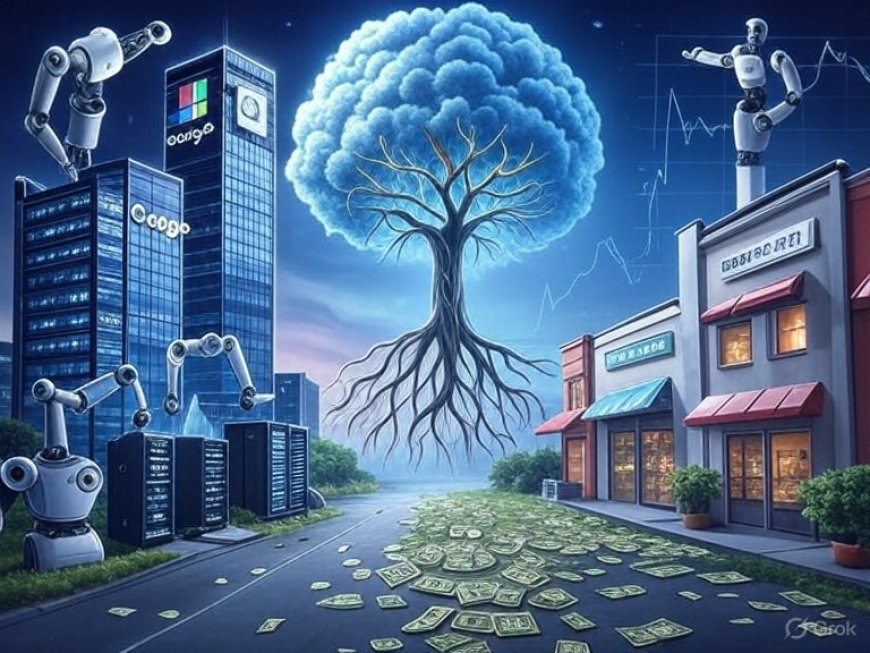AI Super‑Stimulus: How Tech Spending Is Propping Up a Slowing Economy
As consumer and business spending slow, massive AI capital investment by Big Tech is driving U.S. economic growth—and reshaping how markets and policymakers view innovation.

By Ronald Kapper, NewsSutra
While traditional drivers of growth—like consumer demand and business investment in structures—have flagged in 2025, a flood of capital spending on artificial intelligence infrastructure has become the surprising backbone of U.S. GDP performance. As broader economic indicators stumble, AI is emerging as the unexpected engine keeping the economy afloat.
Unpacking the AI-Led Growth Surge
In the second quarter of 2025, investment in AI—from data centers and cloud infrastructure to custom chips and energy systems—accounted for more than one-third of GDP growth, offsetting weakness in consumer spending and manufacturing. Economists describe the wave of AI capital expenditure as a critical “re‑industrialization” effort, especially in U.S. tech hubs like Northern Virginia and Texas.Reuters+9Reuters+9Axios+9
Firms like Microsoft, Alphabet, Amazon, and Meta are on pace to spend nearly $400 billion in AI-related capex in 2025, dwarfing typical tech operating costs. This surge has made investment in information processing one of the fastest-growing segments of the economy, even as other sectors flatten.Axios+1The Wall Street Journal+1
Economic Disconnect: AI Up, Traditional Activity Down
Despite the AI-driven lift, key economic indicators remain soft. Consumer spending has weakened, manufacturing continues to contract, and the labor market, while relatively stable, shows signs of cooling. GDP expansion has slowed to around 1.2% annualized, and inflation pressures—partly tied to higher tariffs—continue to squeeze household budgets.Vox
Meanwhile, conventional business investment in machinery and equipment remains fragile. Spending on structures is shrinking, and growth in intellectual property investment—where AI sits—is one of the few bright spots.The Wall Street Journal+9Deloitte+9Sherwood News+9
Risks in the AI Paradigm
The current boom comes with its own blind spots. Heavy AI capital spending is reducing free cash flow across tech giants, raising concern over balance sheets if AI fails to deliver profitability quickly. Analysts note that this model resembles the dot-com era—as asset-heavy and speculative, though backed by mature firms.The Wall Street Journal
Energy infrastructure constraints further complicate the picture: AI data centers demand vast power, and regions like Northern Virginia face lengthy grid connection delays, dampening scalability.en.wikipedia.org+1Axios+1
Economists also identify what they call a **“productivity paradox”—**where massive IT and AI investment do not yet show proportional gains in output. AI news shocks do lift markets immediately, but actual productivity growth may lag for years, depending on how widely and effectively the technology diffuses.richmondfed.org
The Long View: Who Wins and Who Then Bears the Cost?
Over the longer term, sustained AI investment could lift total factor productivity (TFP) and permanently increase GDP—as much as adding $400 billion in economic value by 2030, according to academic projections.news.stanford.edueconomist.com But if expectations are overstated, or returns slow to materialize, the excess spending could result in financial strain across corporate and public sectors.
On the labor front, AI’s impact remains uneven. PwC reports that industries most exposed to AI have seen wages rise twice as fast as others—and are growing revenue per employee three times faster—but gaps remain as routine roles feel the pressure.pwc.com
What Comes Next: Key Trends to Watch
-
Corporate Outlook: Will AI spending continue at this pace? Analysts warn of capex fatigue if free cash flow fails to recover.
-
Policy Perspective: Federal interest rate decisions and trade policy will affect inflation and cost structures tied to AI investment.
-
Equity Markets: Tech stocks—especially AI-related giants—account for a growing share of S&P 500 earnings. A market rotation may emerge if broader investment looks attractive.MarketWatchMarketWatch
-
Workforce Dynamics: Economic inclusion hinges on whether AI-driven gains translate into new jobs, wages, and training—not just concentrated returns for capital holders.











